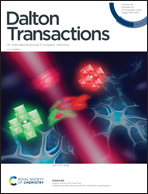Copper(i) complexes bearing mesoionic carbene ligands: influencing the activity in catalytic halo-click reactions†
Abstract
Metal complexes of mesoionic carbene (MIC) ligands are known to catalyze a variety of chemical transformations. In this contribution, we report on the synthesis of a dicationic dicopper(I) complex containing a di-MIC ligand. Two routes are presented for the synthesis of the dicopper complex: Ag-mediated transmetalation and direct deprotonation. For the Ag-mediated transmetalation route, the detection and isolation of several Ag-containing intermediates that are relevant for the final formation of the aforementioned dicopper complex are reported. We then investigate a series of copper(I) complexes based on MIC ligands as precatalysts for the azide halo-alkyne (Click) cycloaddition reaction. In a comparative study, three different halide-containing (I, Br, Cl) substrates have been investigated with different catalysts to survey the behaviour for mono/di-copper-MIC complexes as well as neutral, mono- and di-cationic complexes. The cationic complexes proved to have superior activities compared to the neutral species. These are the first reports on the use of Cu-MIC complexes as precatalysts for the halo-Click reaction.



 Please wait while we load your content...
Please wait while we load your content...